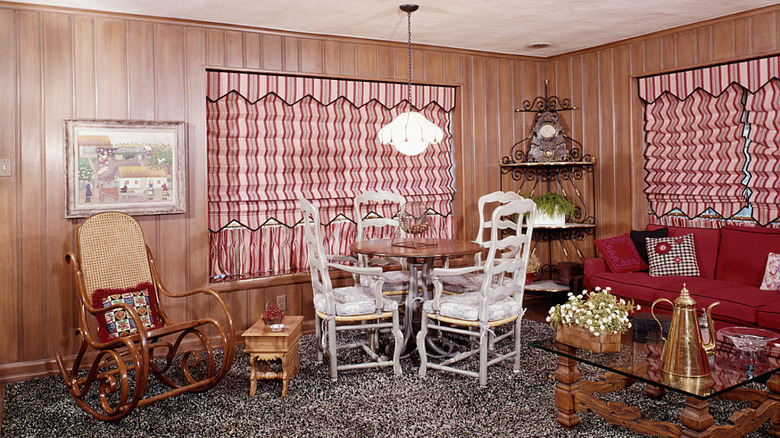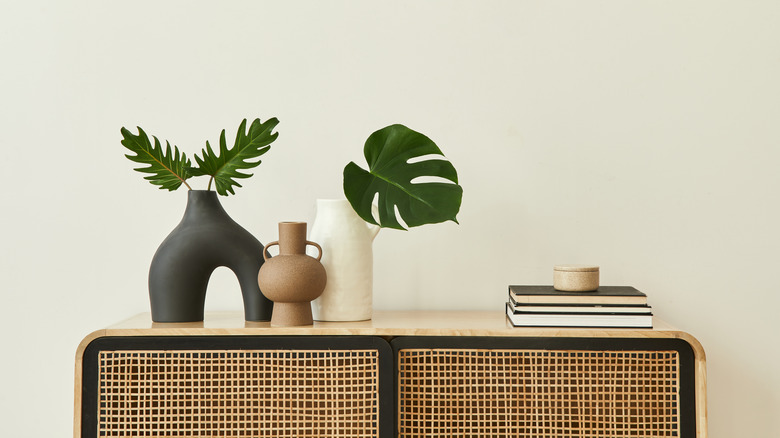HGTV's Hilary Farr Thinks These Old-School Wall Designs Should Be Left Behind
On HGTV's hit series "Love It or List It" and her newest show "Tough Love," Hilary Farr isn't scared of giving homeowners her honest opinions about what works and what doesn't in home design. But, Farr doesn't just bring her opinions to the table. Using her expertise, she knows exactly how to utilize interior design to create a perfect blend of timelessness and on-trend elements in her clients' homes. The HGTV host knows which outdated design trends should stay in the past and which vintage home designs are making a comeback and can be elegantly incorporated for timeless appeal.
But, there's one retro trend that Hilary Farr has no love for, and that is outdated wood paneling on walls. This style came to prominence in the 1970s when vertical paneling was seen as affordable and stylish, and it now brings back memories of old-school sunken living rooms, shag carpets, and lava lamps. While some individuals are eager to leave wood paneling in the past, others predict that this style is poised for a resurgence as part of a larger 70s-inspired design renaissance. This prediction is supported by Grand View Research. The firm suggests that the wood-panel-based market is expected to grow by almost 7% per year. But, despite all the design buzz, Hillary Farr simply isn't backing this trend, and below we discuss why it's a no-go for her, along with alternatives to wood paneling you may want to consider instead.
Why HGTV Host Hilary Farr won't back wood paneling on walls
Fans of Hilary Farr know that she's an expert at making homes more beautiful, functional, and subtly elegant. Although some may say that wood paneling is coming back in style, Farr still isn't a fan of the look. In Season 2, episode 6 of "Tough Love," the homeowners, who're happy with their mid-century living room, said, "We are on the fence about whether to stay with this wood paneling or not, but for right now we're leaning into it." Farr wasted no time in replying, "I think you might lean back out again."
The HGTV designer's disgust for this outdated wall design isn't just a personal preference, but also part of Farr's interior design ethos that prioritizes flow, function, and timeless materials. "I do like the concept of mid-century homes but ... the way people lived in 1950 is so completely different and now there is discord ... it just doesn't work," she added, later in the episode. And, as Farr has stated she doesn't pay trends any mind, neither the predictions about wood paneling's resurgence, nor the homeowners' sense of nostalgia could change her mind.
Prone to warping, cracking, shrinking, drying, and deteriorating under changing weather conditions, retro wood paneling isn't just a questionable design choice, it's questionable from a functional perspective as well. Requiring lots of care and maintenance, it's also not universally popular with buyers, so there's a chance it may hurt your resale value when it's time to sell.
Ways to elegantly incorporate retro décor without going overboard
If you're a fan of the retro resurgence, let us put your mind at ease. There are ways to design with retro décor while maintaining a timeless, elegant appeal in your home. Our first bit of advice is to opt for a theme that's stood the test of time and that you can easily carry from one room to another for a sense of harmony throughout the home. While a 70's design scheme may be daunting to maintain in every room of the house, picking a mid-century modern or contemporary eclectic aesthetic gives you a broader style family to work within and more elements to choose from, while also making nods to your favorite bygone eras.
You may want to take a page out of Hilary Farr's book and honor vintage eras with more subtle, contemporary design elements that pay homage to the past while blending with more modern styles. For fans of mid-century modernism, she removed the living room's outdated wood panel wall coverings but incorporated a gorgeous geometric fluted wood range cover in the kitchen for a wood feature with more modern appeal. Besides renovating finishes, you can also incorporate retro elements with furniture, décor, and art that can be switched out if you're craving a change of vibe, or when it's time to sell. A rattan cabinet, geometric art, and antique lamps are great ways to make a space feel groovy, but also keep it versatile enough to change with the times if you desire.



